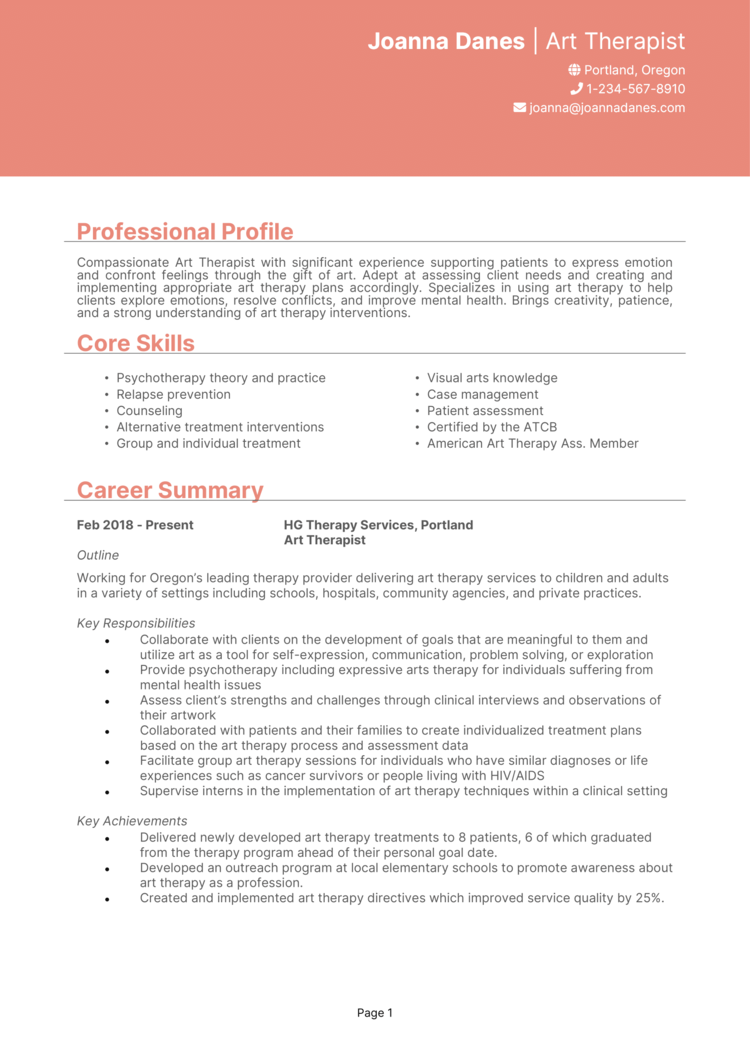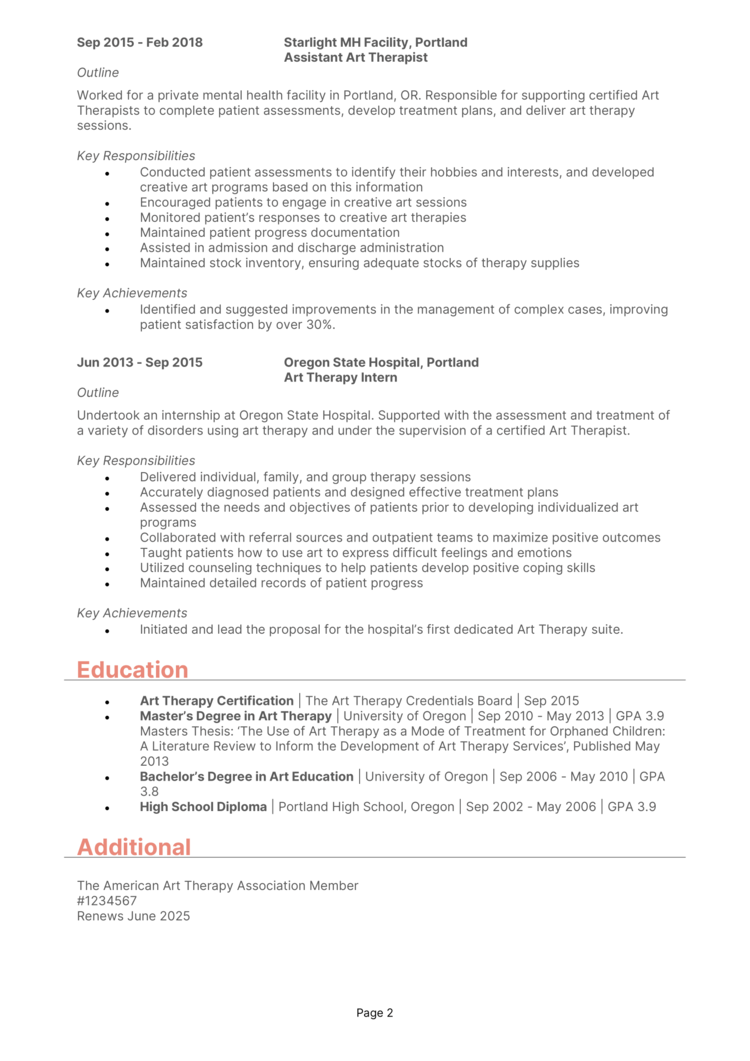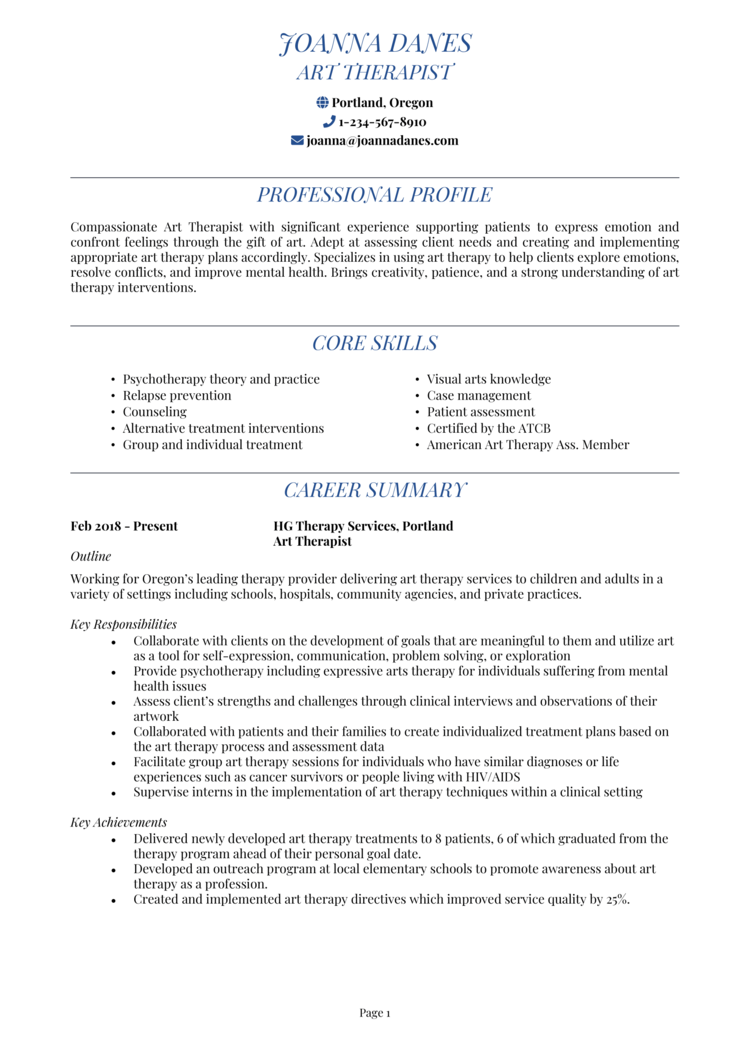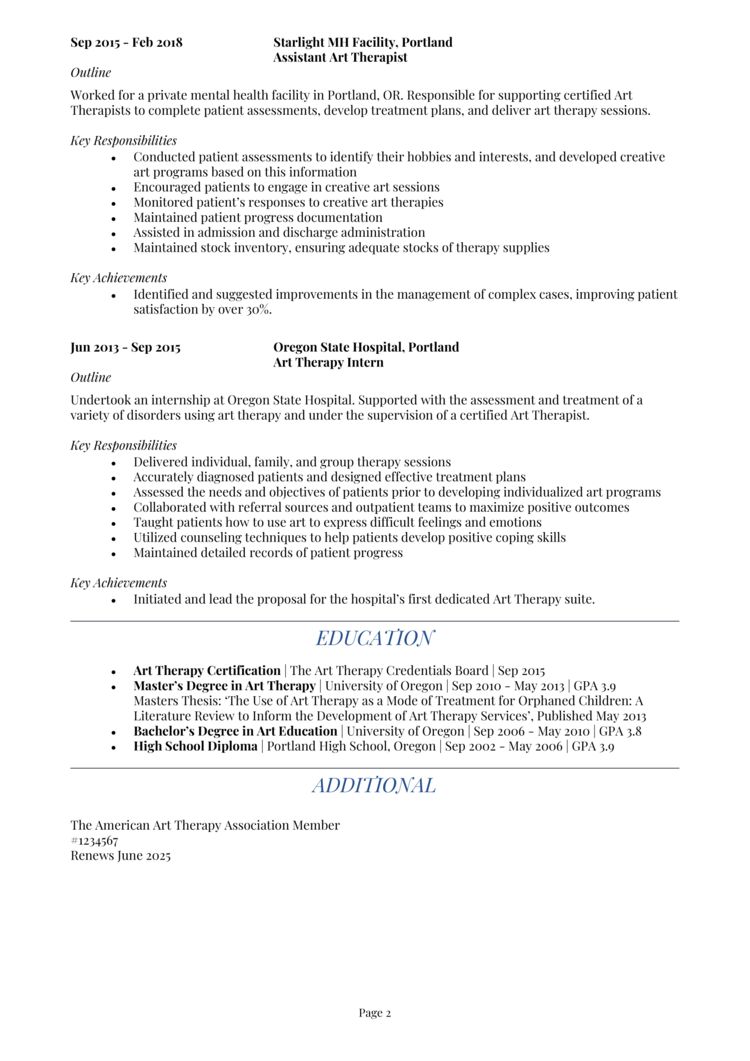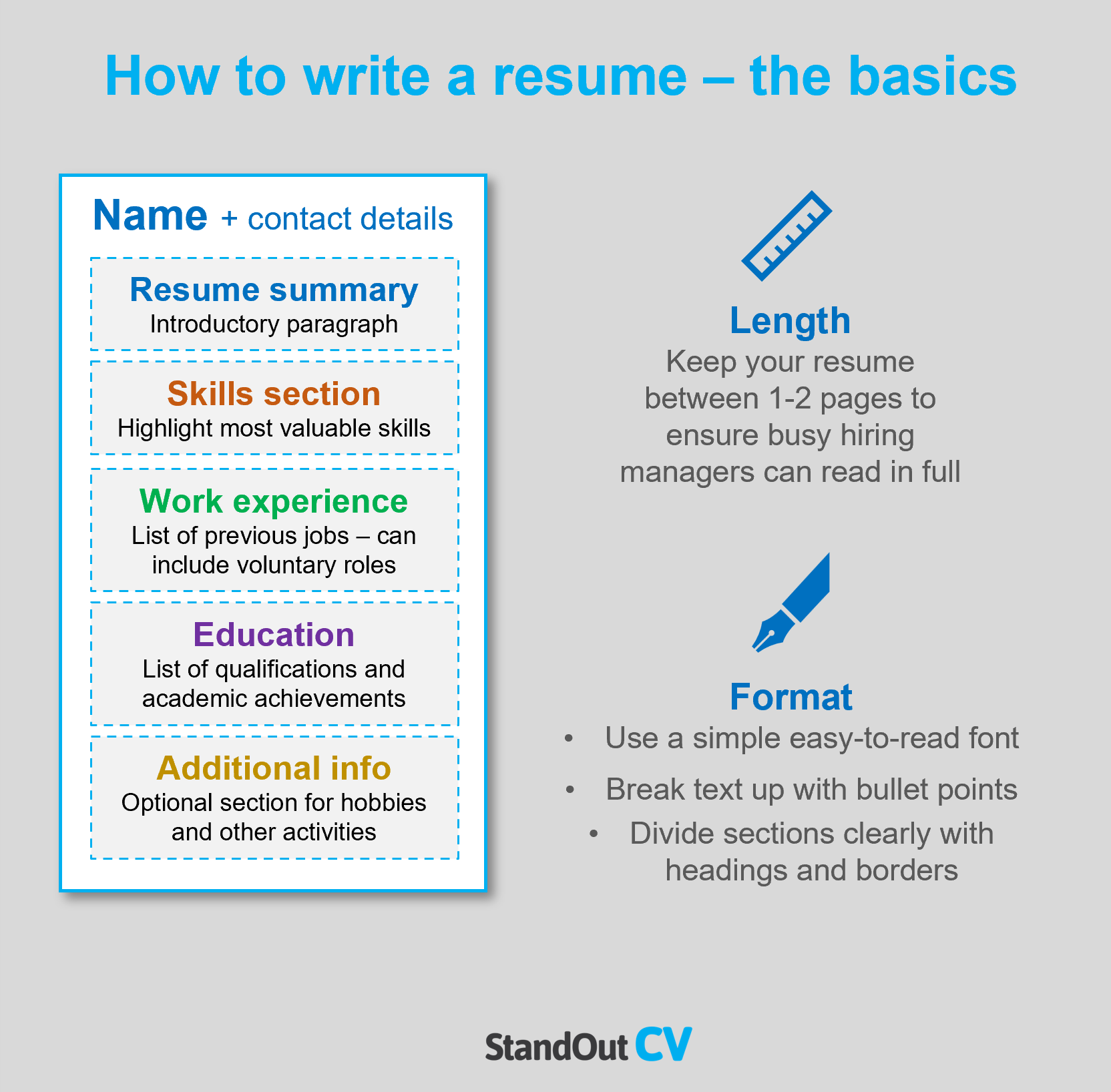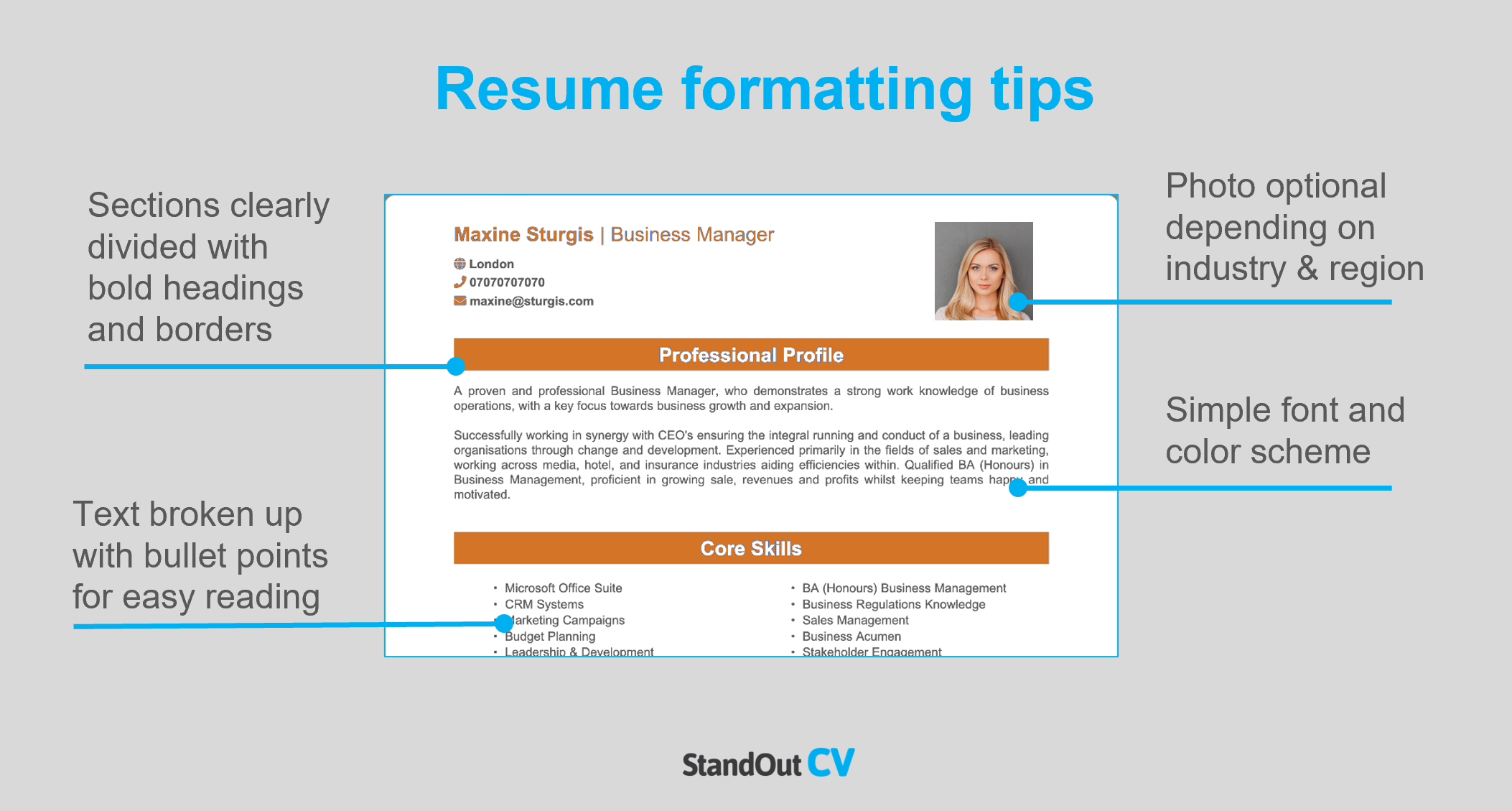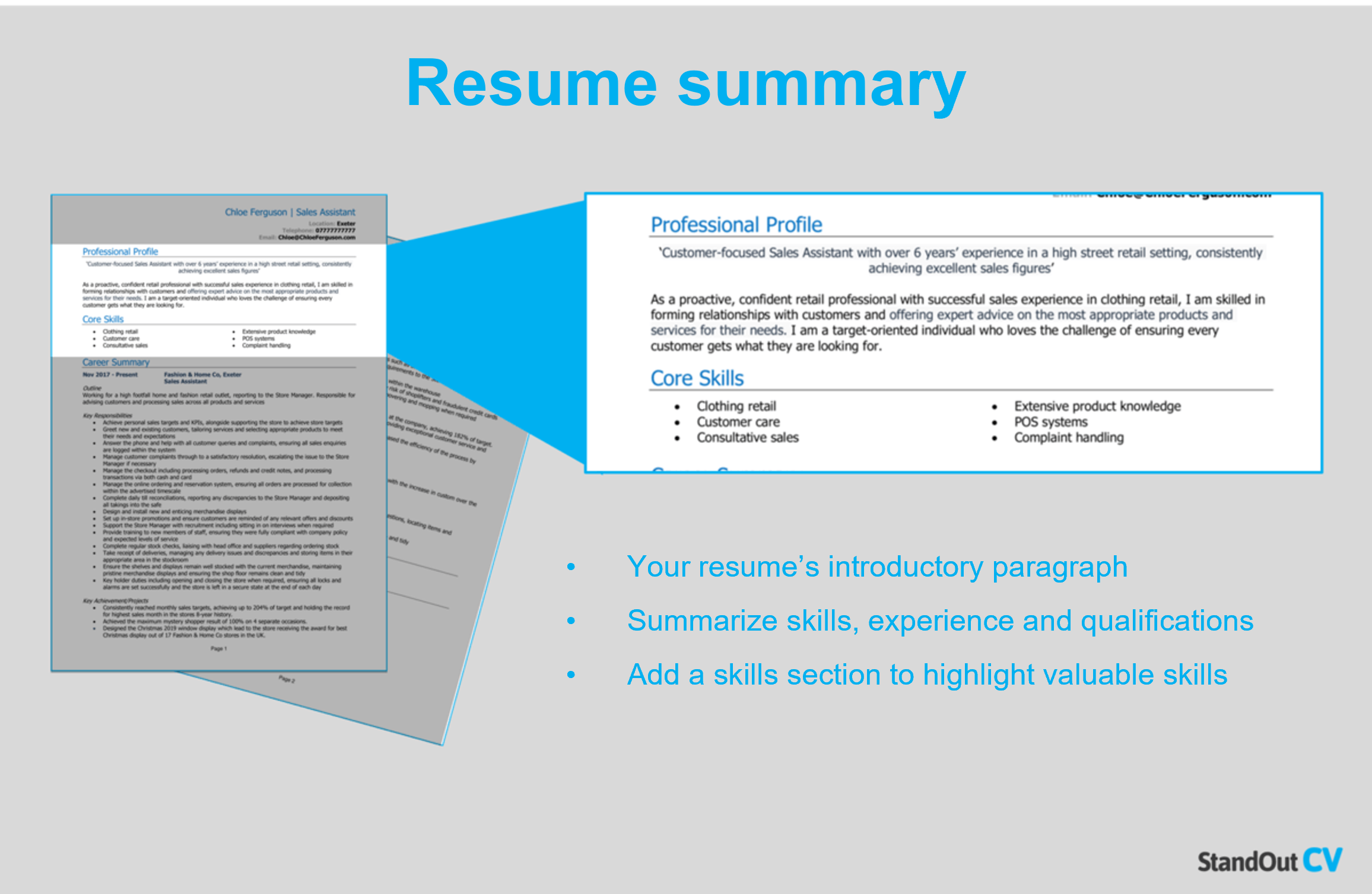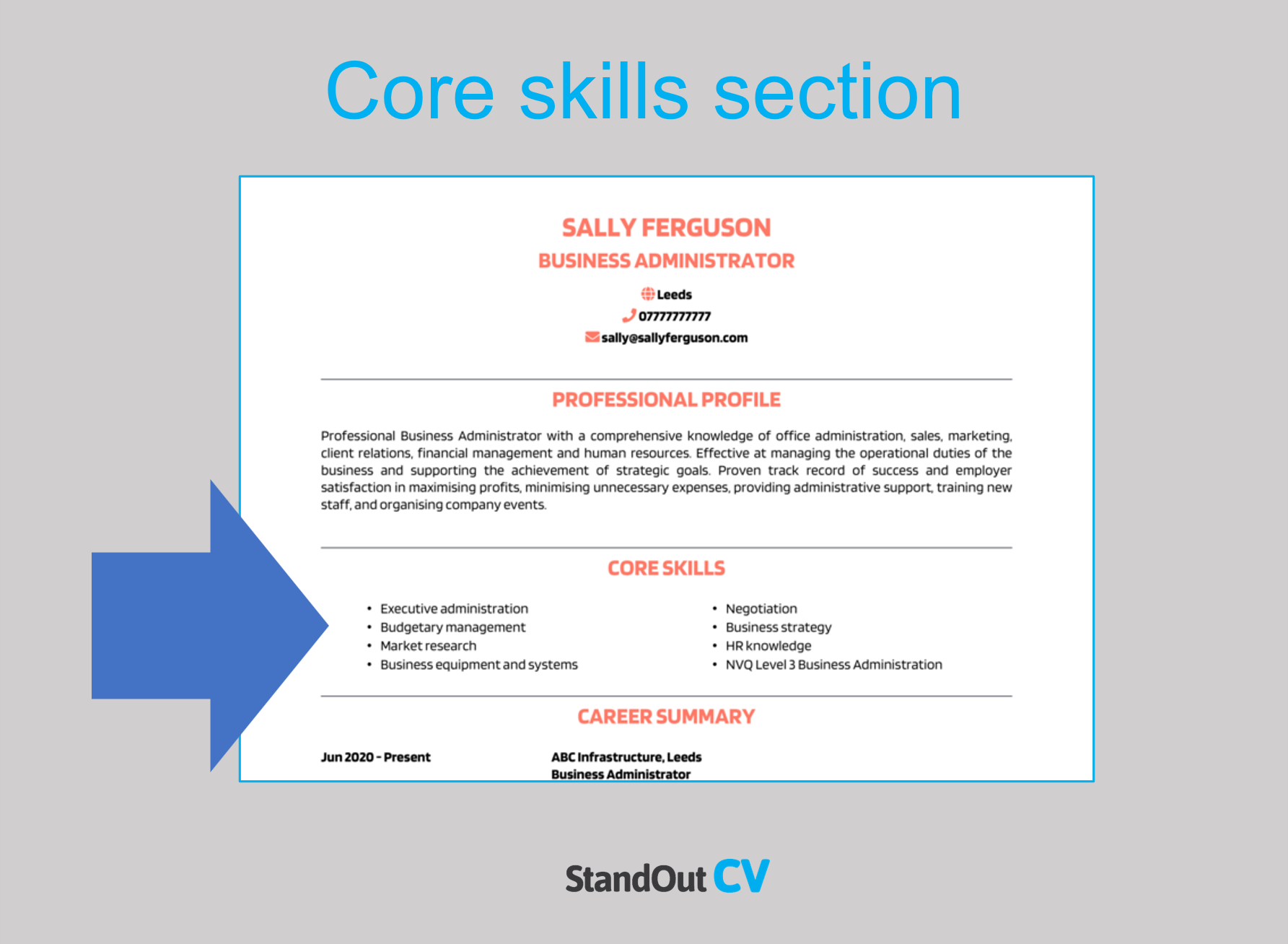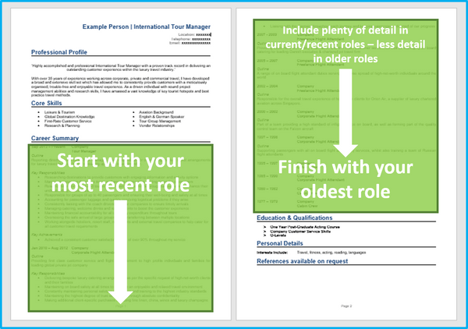Do you want to use your artistic abilities to help others? Then a career in art therapy is perfect for you.
But first, you need to make sure your resume is as creative and captivating as your artwork.
To get you started, we’ve created an art therapy resume example and writing guide to help inspire your own.
Contents
|
Art Therapy Resume Example 1
Art Therapy Resume Example 2
The example Art Therapy resumes above show you how a professional resume should look, along with the type of content it should contain.
You’ll notice that the information is well organized across the page, and its easy for busy hiring managers to spot the candidate’s important skills.
Keep this in mind as you write your own resume.

Art Therapy resume layout and format
If you want to get noticed in the job market, you have to pay attention to the format and layout of your resume.
Essentially your resume needs to look highly polished, and provide hiring managers with an easy reading experience.
Use these resume formatting tips to get a head start on this.
Resume formatting tips
- Length: Keep your resume to 2 pages or under. You’ve probably heard that recruiters and hiring managers don’t have lots of time to read every resume, so keep yours brief if you want to ensure that they read all of the important info in yours.
- Font and text: Readability is the name of the game when it comes to your resume. Ensure yours is a dream to read by using a simple clear font, and breaking the text up with plenty of bullet points and short paragraphs.
- Design & structure: Go with a resume design that looks good, but also allows for easy reading and navigation for employers. Ensure the page is clearly split up into sections by adding large font headings and dividing borders. Keep the color scheme simple and don’t overcrowd the page.
- Photos and images: You are not obliged to add a photo to your resume in the USA, but it can be a nice way of adding some life to the document.
Quick tip: Formatting a resume to look professional can be difficult and time-consuming. If you want to create an attractive resume quickly, try our quick-and-easy Resume Builder and use one of their eye-catching resume templates.
Resume layout
Here’s an overview of the sections you should add when writing your resume.
- Name and contact details – Stick these details at the top, so they are easy to find.
- Resume summary – A punchy paragraph summarizing your skills and knowledge, enticing recruiters to read more of your resume.
- Skills section – Short list of your most valuable skills, enabling recruiters to quickly spot your suitability.
- Work experience – Showcase your previous employment, starting with your most recent roe and working backwards – voluntary work and college placements can be included if you have no paid experience.
- Education – A summary of your most relevant qualifications and academic achievements
- Additional info – An optional section for that other attributes that may boost your application, such as hobbies or clubs
Now here’s exactly what you should include in each of these sections in your resume.
Resume Contact Details
Make it easy for hiring managers to contact you by adding your contact details to the top of your resume.
Keep this section small to save space and include the following.
- Name and profession title
- Telephone number – Ideally your cell phone so you can answer quickly.
- Location – Add your general location such as LA or New York
- Email address – Use a professional looking one with no nicknames.
You can add a link to your LinkedIn profile if you have one – you do not need to include personal details like date of birth or marital status.
Art Therapy Resume Summary
Start your resume with a bang by adding a powerful summary to the top, summarizing your most valuable skills and experience.
This short paragraph is your chance to show recruiters why you are a perfect fit for the job and encourage them to read more of your resume.
Tips for creating an strong resume summary:
- Keep it brief: Aim for a short punchy paragraph of 4-7 lines. This is just enough info to showcase why you’d make the perfect hire, without going into excessive detail and overwhelming busy recruiters at such an early stage in the resume.
- Tailor it: Recruiters will be scanning for the skills and knowledge they mentioned in the job description, so add as many as you can to your summary.
- Avoid cliches: You may be a “team player who always give 110%” but generic phrases don’t tell employers much about you in reality – stick to factual information.
Example resume summary for Art Therapy
What to include in your Art Therapy Resume summary?
- Summary of professional experience: Summarize the type of work you have done in the past and the benefits you have delivered for the organizations you worked at.
- Relevant skills: Highlight your skills which are most relevant to Art Therapy jobs, to ensure that recruiters see your most in-demand skills as soon as they open your resume.
- Essential qualifications: Mention any Art Therapy qualifications that are important to your profession in the summary briefly, to show you are qualified to carry out the role.
Quick tip: Choose from hundreds of pre-written summaries across all industries, and add one to your resume with one click in our quick-and-easy Resume Builder. All written by our recruitment experts and easily tailored to suit your unique skillset.
Core skills section
In addition to your resume summary, your core skills section provides an easily digestible snapshot of your skills – perfect for grabbing the attention of busy hiring managers.
As Art Therapy jobs might receive a huge pile of applications, this is a great way to stand out and show off your suitability for the role.
It should be made up of 2-3 columns of bullet points and be made up of skills that are highly relevant to the jobs you are targeting.
Best skills for your Art Therapy resume
- Psychotherapy theory and practice – Utilize a variety of theories and practices to support patients to gain an understanding of their disorder and how to recover from it.
- Visual arts knowledge – Use a variety of arts, skills, techniques, processes, and materials to support patients as they explore a range of forms, styles, and contexts.
- Relapse prevention – Identify potential upcoming relapses in patient recovery and implement steps to prevent this from occurring.
- Patient assessment – Gather information on the psychological, physiological, and sociological history of the patient to devise effective treatment plans.
- Group and individual treatment – Facilitate individual and group patient therapy sessions to support patient recovery.
Quick tip: Our quick-and-easy Resume Builder contains thousands of in-demand skills for every profession that can be added to your resume in seconds – saving you time and greatly improving your chances of landing job interviews.

Work experience section
Now that you’ve reeled recruiters in with your awesome summary, it’s time to delve into your work experience.
Here you’ll list your previous jobs (starting with your most recent and working backward) and showcase how you apply your skills in the workplace.
Provide lots of detail in recent jobs, and less in older roles.
If you have no relevant paid experience, you can include voluntary work and placements – but if you have lots of experience, you can leave out some of the really old jobs.
Structuring your job descriptions
It’s easy to overwhelm readers when writing about a job you have been doing for years or even months.
Break the information up like this to keep it simple for recruiters to understand.
Job outline
Begin each job with a short summary of who the organization is, where you sit within it, and what the main goal of your position is.
Key responsibilities
List your notable responsibilities in short sharp bullet points to demonstrate your input and how you contributed to the organization’s success.
Highlight the skills that are most important to the roles you are applying for.
Key achievements
Round off each job by adding some impressive achievements you made in the role.
Anything you’ve done that has made a big impact on your employer will make a good impression, think; generating revenue, saving costs, or improving a product.
Quantify your achievements with number where possible e.g. “reduced call wait time by 10%”
Example job for Art Therapy resume
Outline
Working for Oregon’s leading therapy provider delivering art therapy services to children and adults in a variety of settings including schools, hospitals, community agencies, and private practices.
Key Responsibilities
- Collaborate with clients on the development of goals that are meaningful to them and utilize art as a tool for self-expression, communication, problem solving, or exploration
- Provide psychotherapy including expressive arts therapy for individuals suffering from mental health issues
- Assess client’s strengths and challenges through clinical interviews and observations of their artwork
- Collaborated with patients and their families to create individualized treatment plans based on the art therapy process and assessment data
Quick tip: Create impressive job descriptions easily in our quick-and-easy Resume Builder by adding pre-written job phrases for every industry and career stage.
Education resume section
Near the end of your resume add your education section
Experienced candidates should keep it brief and focus on professional qualifications – and junior candidates can include high school diplomas, college degrees etc.
Additional info for your resume
The additional info section is optional but can be useful if you have anything else to add that could benefit your application.
For example ,you may have some hobbies and interests that are relevant to your job – or you might have awards or publications to shout about.

Writing your Art Therapy resume
A winning Art Therapy resume should look great, read well, and sell your skillset to hiring managers.
If you follow the steps above, you should be able to bag yourself a top job in no time.
And don’t forget you can use our quick-and-easy Resume Builder if you want to save time and ensure your resume contains the very best content.
Good luck with your job search!
